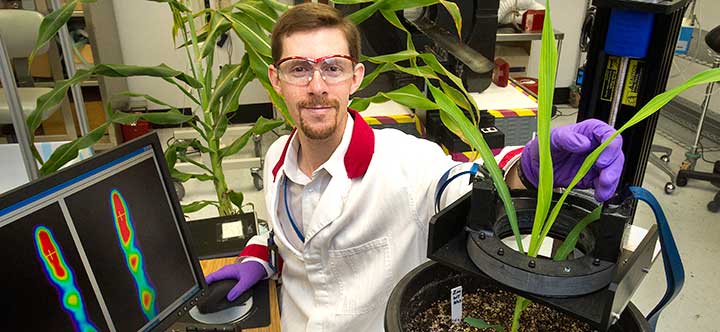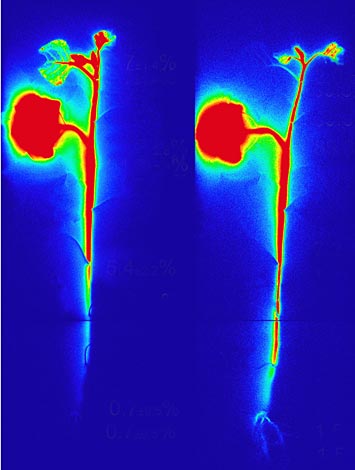PET Plant Images for Bioenergy Research
Talking plants and PET imaging with BNL plant biologist Ben Babst
October 12, 2012

Ben Babst with a prototype of a positron emission tomography (PET) device for imaging plants. This device is being designed and built through collaboration between BNL’s Biosciences and Physics Departments, its Instrumentation Division, and Sherbrooke University in Canada.
Ben Babst has seen things that no one else has ever seen before. A plant biologist in Brookhaven Lab’s Biosciences Department, formed earlier this month when the Biology and Medical Departments merged, Babst is among pioneering researchers who are some of the first in the world to study plants using a technique called positron emission tomography or PET imaging, which is more commonly used to diagnose cancer and study brain activity. With this innovative use of PET imaging technologies, Babst has actually watched plants shift nutrients from their leaves down to their roots while under attack by gypsy moth caterpillars — the plants safeguarding energy from their furry, leaf-chomping assailants. This, along with Babst’s other investigations of transport and metabolism in plants, show much promise toward enhancing plants’ abilities to make substances for biofuels that could someday power vehicles, homes, and industry.
“It seems that there is an exciting moment every time we design a new type of experiment, because we are watching things that nobody has seen before.” — Ben Babst
Babst first came to Brookhaven Lab as a graduate student in 2003. He returned to the Lab after earning a Ph.D. from Tufts University and holding two postdoctoral research positions. In 2010, he received a Goldhaber Postdoctoral Fellowship from Brookhaven. These prestigious fellowships are three-year appointments awarded to candidates with exceptional talent and credentials, who have a strong desire for independent research at the frontiers of their fields. Originally from Frederick, Md., Babst now lives in Manorville with his wife Clare Norcio, a history professor, and their two children. In addition to the 480th Brookhaven Lecture Babst gave at Brookhaven in September, titled “PET Plants: Imaging Natural Processes For Renewable Energy From Plants,” he explained his research for a solution for the nation’s energy challenges here.
What is the focus of your research?
Plants can’t run away from insect attacks and they can’t escape from drought like that suffered in the Midwest this summer. To suit changing environmental conditions, they adjust internal processes such as metabolism and “vascular” transport, which circulates resources throughout the plant. The goal of my research is to provide basic biological information about these adaptations, which are needed to develop crops dedicated for bioenergy — crops that grow large and fast, can be converted to fuel efficiently, and can grow vigorously on less-than-ideal lands to avoid a scenario of competition for real estate to produce both food and fuel.
At Brookhaven, I use radioisotopes and Positron Emission Tomography (PET) to see and quantify how biochemicals are distributed throughout an entire plant. This is “basic” research that supports DOE’s bioenergy mission through its Biomass program.
What’s “cool” or interesting about that?
It’s very cool to be the first person to actually see various phenomena happening in plants. Watching video created in our lab that shows the movement of sugars and plant hormones is an eye opener. It’s also rewarding to contribute toward solutions to the energy crisis that is facing us in the U.S.
What are you working on now?
I am addressing several areas of plant biology, including hormone signaling in grass stem growth and fundamental mechanisms of vascular transport. For example, I am trying to understand the mechanisms that control how nutrients, including sugars, are allocated to different parts of the plant — roots, stems, and leaves. Sugars can be produced in leaves through photosynthesis, and then distributed to stems and roots, where they are metabolized to release energy that the plant needs to grow. We can tap those sugars for our energy needs — for both food and fuel. Converting sugars to biofuel is a very efficient process, because sugars can be fermented directly.
In one of my current projects, I am working to determine how sugars accumulate in stems of certain grasses, such as sugarcane and sweet sorghum. Sorghum is a relative of corn, and compared to sugar cane, it is much better adapted to grow in the temperate climate that is prevalent in much of the United States. Understanding the mechanisms that drive sugar accumulation in sweet sorghum will lead to new ideas for increasing sugar yields, not only for sorghum plants, but for other bioenergy crops as well.
Why do this at Brookhaven Lab?
This plant biology research for bioenergy requires specialized equipment and expertise. PET technology has been used for medical studies for decades, but there are only a few groups in the world, so far, that use it for plant research. Since much technology for PET imaging was developed at Brookhaven Lab, the Lab is unique in the world. Here, we have the specialized equipment as well as people with electronics and chemistry expertise. Applications for plant science are still fairly young, so it is invaluable for me to work with a team of experts who can help find solutions when new challenges arise.

The PET image of a plant before a gypsy moth caterpillar attack (left) shows more nutrients in the plant’s leaves. The PET image of a plant after the caterpillar attack (right) shows that nutrients are being “bunkered” as they are transported from the plant’s leaves to the stem and roots. These findings inspired a number of research teams to conduct follow-up studies as well as new interest in developing strategies to reduce yield losses by enhancing plants’ natural tolerance mechanisms.
Have your efforts contributed to any discoveries?
Yes. In earlier work, we found evidence that plants may defend themselves from damage, such as a gypsy moth caterpillar attack, by bunkering nutrients below ground to the roots. It has long been known that plants can make toxins to repel herbivorous insects, but our studies suggested a broader whole-plant response to a harmful environmental condition.
More recently, my studies with corn, or maize, mutant plants have raised new questions about the phloem that transports the sugars plants need to grow from the leaves to the roots, stem, and flowers. Right now, plant biologists think that sugar loading into the phloem is what drives nutrient-containing sap to flow. The maize mutant plants I am working with export very little sugar. But surprisingly, we found that the flow of sap in the phloem is only reduced moderately compared to “normal” plants in the wild. That means something else, not sugar loading alone, is helping to drive sap flow in these plants. Identifying that something else is what we need to address now. I think the results of this research will ultimately lead to revisions in plant biology textbooks.
Who does your work benefit?
My work contributes to fundamental knowledge for the field of plant biology. My work is part of a larger process, as it provides the knowledge that plant genetic engineers and breeders need to develop crops well-suited for bioenergy. The end result — a cheaper, more stable, and more environmentally friendly energy supply — will benefit everybody.
What was one of the most exciting moments of your career?
It seems that there is an exciting moment every time we design a new type of experiment, because we are watching things that nobody has seen before. The example I mentioned earlier about finding evidence that plants may bunker nutrients below ground during an insect attack was one of the most exciting moments so far. Our findings triggered a host of follow-up studies by other research groups, and it also inspired interest in strategies to reduce yield losses by enhancing plants’ natural mechanisms. I anticipate many more exciting moments as we continue to visualize plant functions that have never been imaged before.
Who do you work with?
I work with many people at Brookhaven Lab, particularly with Rich Ferrieri and Abhijit Karve of the Biosciences Department and members of the PET imaging team led by Joanna Fowler. I also have ongoing collaborations with David Braun at the University of Missouri and Ismail Dweikat at the University of Nebraska.
Who funds your work? And why are they interested in what you’re doing?
Our group’s funding from the DOE Office of Biological and Environmental Research was renewed recently. My collaborations with Braun and Dweikat are supported with a grant from the U.S. Department of Agriculture (USDA) and DOE through the Plant Feedstock Genomics for Bioenergy program. DOE and USDA are interested in our work because our using PET technologies for plant biology shows promise for applications that address challenges in expanding the production of plant feedstock that can be converted efficiently into usable bioenergy.
Have you won any awards? Which one are you most proud of?
I am most proud of the Goldhaber Fellowship I received from Brookhaven Lab. The Goldhaber Fellowship has given me more freedom to develop new lines of research than is possible with a typical postdoctoral position.
Do you have any special talents?
I used to play piano and guitar. Now, I mostly read to relax, rather than nurturing talents. I enjoy hiking and camping with my family, and throwing a baseball or Frisbee when I’m feeling less adventurous.
2012-3379 | INT/EXT | Newsroom









